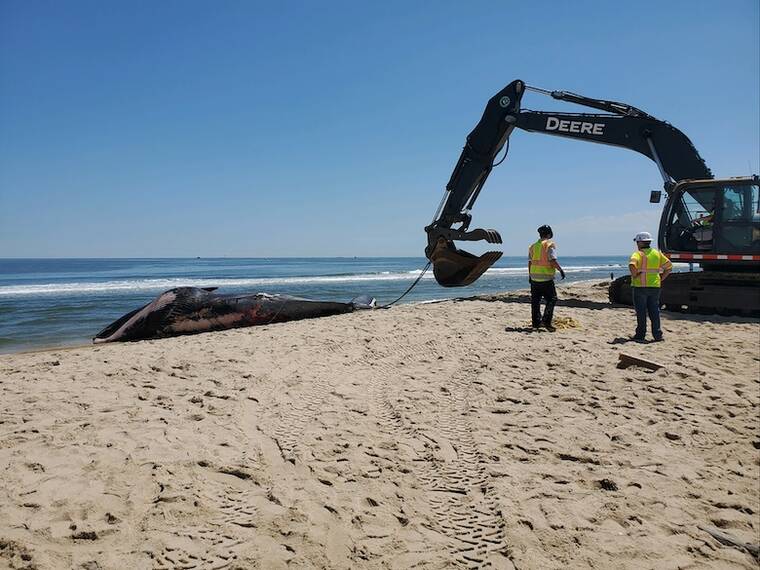44-foot whale found dead on bow of cruise ship in New York

ATLANTIC MARINE CONSERVATION SOCIETY VIA THE NEW YORK TIMES / MAY 8
A whale that was discovered on the bow of a cruise ship that arrived in New York was taken to Sandy Hook, N.J., for a necropsy. The endangered sei whale, usually found in deep waters, was discovered on the bow of a cruise ship as it arrived at the Brooklyn Cruise Terminal, marine authorities said.
NEW YORK >> As the cruise ship approached New York on Saturday, it was found to be carrying a grim, and unexpected, catch: the carcass of a 44-foot-long endangered whale, draped across its bow.
The whale, which marine authorities described as a sei whale, is known for its rapid swimming and preference for deep waters, far from the coast. Its body was discovered as the ship neared the Brooklyn Cruise Terminal, and authorities were “immediately notified,” said MSC Cruises, which owns the ship.
A spokesperson for the company said in an email that it had “comprehensive measures” in place to avoid such collisions, including training deck officers and altering itineraries in certain areas to avoid them. “We will continue to evaluate and update our procedures with our partners and the authorities,” she said.
Marine authorities said that they had towed the animal, estimated to weigh some 50,000 pounds, from the bow, and transferred it by boat to a beach in Sandy Hook, New Jersey, where they conducted a necropsy Tuesday.
The investigation is continuing, but preliminary results — broken bones in the whale’s right flipper; tissue trauma along its right shoulder blade; a full stomach; and decent layer of blubber — all pointed toward the animal having been in otherwise good health when it was likely struck and killed by the ship, said Robert A. DiGiovanni, the chief scientist of the Atlantic Marine Conservation Society, which is leading the investigation.
The whale was already “pretty decomposed” by the time scientists began the necropsy, he added, so they worked quickly to collect samples that could be tested for contaminants and other biotoxins that would indicate any other relevant health issues. “It looks like the animal was alive and it was hit by a vessel,” he said, noting that investigators had not ruled out other factors.
Don't miss out on what's happening!
Stay in touch with breaking news, as it happens, conveniently in your email inbox. It's FREE!
DiGiovanni said that his conservation group, which is federally authorized to respond to marine mammal strandings in New York, had dealt with around 100 whales over the past several years, many of which had been entangled in nets or struck by vessels. Most of those whales were humpback and North Atlantic right whales, he added, noting that it was more uncommon to come across a sei whale.
Sei whales usually live in subtropical, temperate and subpolar waters and are named after the Norwegian word for pollock, “seje,” because the mammals are often found together with the fish. Their long, sleek bodies are usually dark blue or black with a cream-colored underside, and are often scarred by shark and lamprey bites.
In the 19th and 20th centuries, the whales were commercially hunted for their meat and oil, decimating their population, which is now designated as depleted under the Marine Mammal Protection Act.
DiGiovanni said that the death was a reminder that humans shared the open water with many other mammals. “When you’re out there, these animals might be there,” he said. “We need to make people more aware about how to operate around these animals.”
A spokesperson for the National Oceanic and Atmospheric Administration said by email that mariners along the East Coast were encouraged to slow down their vessels, stay alert, and report any sightings of dead, injured or entangled whales to authorities.
© 2024 The New York Times Company



